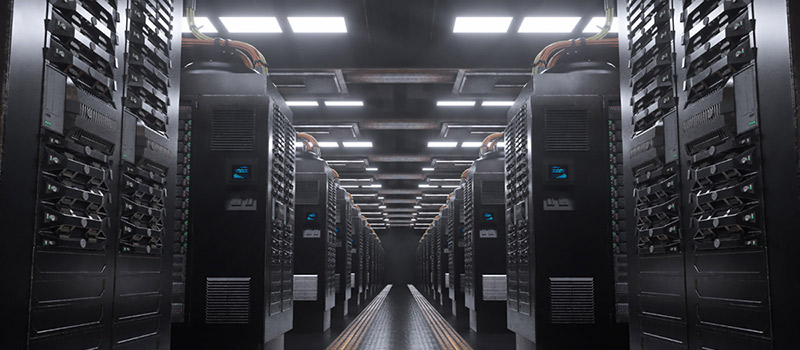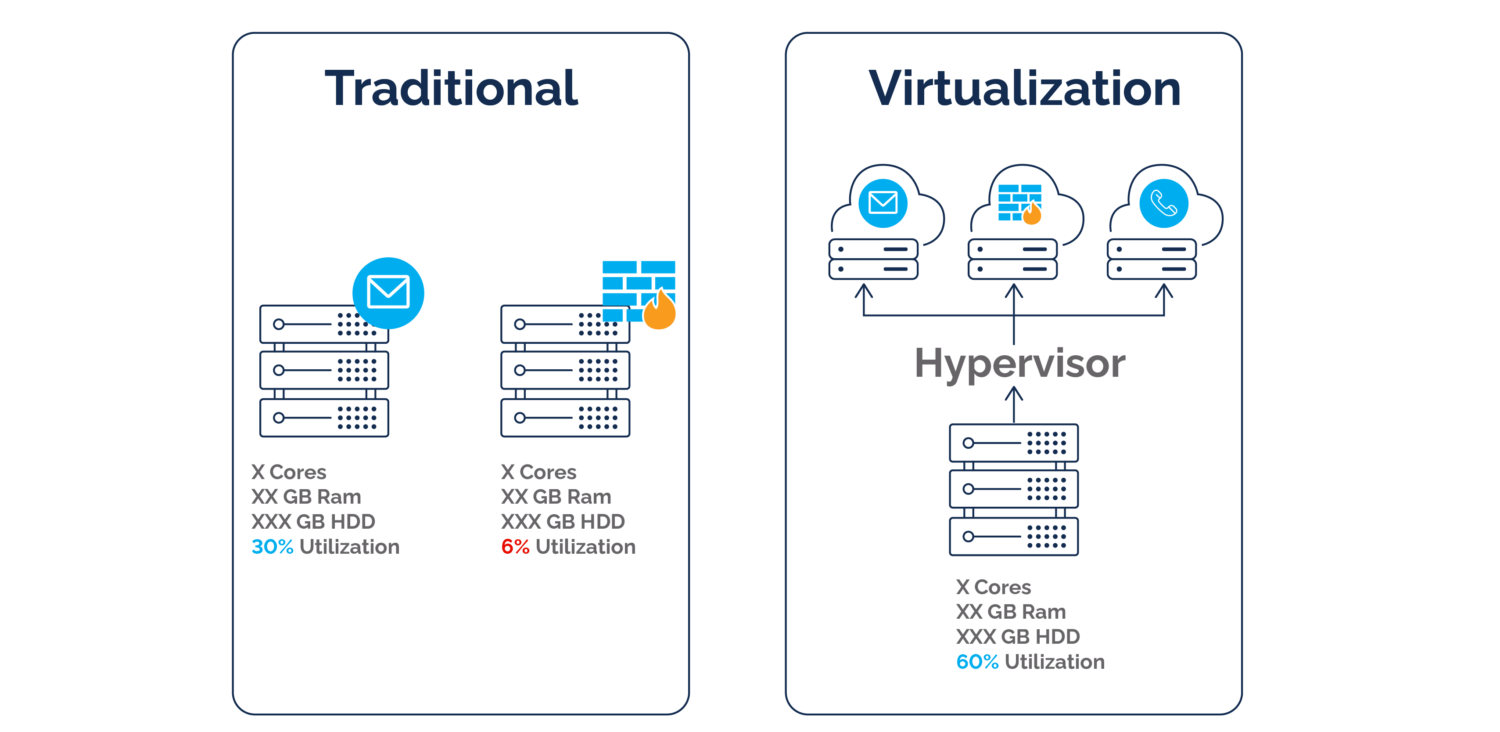Traditional Data Center vs. Virtualization – Differences and Benefits
Park Place Managed Services
Jump-to Outline
What Is a Traditional Data Center?
Benefits of a Traditional Data Center
Drawbacks of a Traditional Data Center
What Is Data Center Virtualization?
Benefits of a Traditional Data Center
Drawbacks of a Traditional Data Center
Difference Between Physical and Virtual Cluster Configurations
Is there a business that doesn’t rely on a data center somewhere? Maybe; but in today’s increasingly digital world, nearly all organizations use data centers of one type or another to support their operations and offer customers online, web, mobile, and other capabilities.
In some cases, traditional data centers are sufficient. With the need to reduce the data center footprint, drive energy efficiency, and become more agile, virtualization has come to more and more facilities. There is also great reliance on virtualized data center architecture in cloud computing — and who today isn’t engaged in the cloud to some extent?
What is the difference between these choices and how is your enterprise to choose? Let’s investigate.
What Is a Traditional Data Center?

A traditional data center is a facility housing IT equipment, such as servers and routers. Data center hardware components and technical elements include:
- Compute, the memory and processing power
- Storage to house data
- Networking to connect the components and to access the internet
- Power and Cooling Infrastructure
For much of the history of IT, traditional data centers tended to be on-premises, often in conjunction with a main corporate office. Today, businesses can also select colocations (facilitates run by third-party data center operators) that operate in a traditional or virtualized manner.
More recently, with the introduction of virtualization, the software-defined data center (SDDC) was born. An SDDC may look a lot like a traditional data center, in that it too houses physical IT equipment. The servers and other technical components in an SDDC, however, will be virtualized.
Benefits of a Traditional Data Center
A physical, on-premises data center has various advantages:
- If you’re starting from scratch, you can build it to suit your own needs. When upgrades are required, you’re in the driver’s seat.
- You can restrict access to the facility to individuals from within your own organization, as well as trusted providers should you so choose.
- Traditional data centers located on-premises can deliver low-latency access to applications.
Drawbacks of Traditional Data Center
On the downside:
- Construction and ongoing data center infrastructure management are typically more expensive for traditional data centers.
- Traditional data centers are less energy efficient and require more cooling.
- A traditional data center relies on static IP addresses.
- Some organizations suffer from hardware vendor lock-in.
What Is Data Center Virtualization?
Data center virtualization uses virtualized servers and virtual machines (VMs). A single physical server can house multiple virtual servers. Repeat such virtualization over all the servers in an environment and you have data center virtualization. Combine physical servers running a single operating system instance with virtualized servers, and you have a physical/virtual mix.
Data center virtualization is central to cloud computing, including private and public clouds. It also makes infrastructure as a service (IaaS) possible.
The SDDC brings the data center and virtualization together across infrastructure with not only virtualized servers but also software-defined storage and software-defined networking.

Benefits of a Data Center Virtualization
Data center virtualization has been rapidly gaining ground. The cloud is a big part of the reason, but a head-to-head comparison between traditional and virtualized data centers reveals significant advantages:
- Greater server utilization results in an overall efficiency boost.
- Doing more with fewer servers slashes the physical footprint of the data center.
- The efficiencies extend to energy and cooling, as fewer hot and power-hungry servers are required to process the same workload, as compared with a traditional environment.
- Virtualization reduces bandwidth requirements for traffic flow.
- There are fewer pieces of physical hardware, including servers and network appliances, to manage and upgrade – potentially meaning less server maintenance to worry about.
- Virtualized environments are easier to scale; deployment of resources is faster.
- Faster data replication and data migration makes backup and recovery easier.
- Virtualization facilitates integration of cloud data services.
Drawbacks of Data Center Server Virtualization
Balancing these pros, however, are some downsides:
- Virtualization demands a large initial investment for setup. Organizations with a significant amount of existing hardware must take into account which equipment will support virtualization.
- Not all software works in a virtualized environment. Hybrid infrastructure is sometimes required to support legacy systems.
- The use of shared devices can open security vulnerabilities. Organizations must learn about data protections for virtual data centers before considering this avenue!
- Virtualization typically moves IT resources away from the user, adding more points of potential failure.
- Shared resources on the devices negatively affects performance — physical servers in a traditional environment are the performance workhorses.
- Allocating new servers is so easy in a virtualized environment that some organizations wind up with server sprawl.
- Some organizations merely replace hardware vendor lock-in with software vendor lock-in.
Difference Between Physical and Virtual Cluster Configurations
Much of the time, IT organizations want their servers to work in clusters. In other words, a group of servers will work together to handle certain workloads, balance loads, and to ensure high availability. This dichotomy is very similar to a physical server vs. virtual server comparison.
Physical clusters comprise a number of physical servers networked together. Physical clusters can be vulnerable to downtime due to the failure of any one of the clustered servers.
Virtual clusters string together virtualized servers or VMs installed on multiple physical clusters. There is virtual and physical networking involved. The resulting clusters tend to be the more manageable and reliable configuration for large-scale applications and are the go-to choice for most large enterprises.
Uptime Is the Goal — Choose the Right Maintenance Partner Regardless of Configuration
No matter whether your organization prefers traditional, virtual, or hybrid infrastructure, you want resources to be available at all times to support your mission. Achieving that goal requires effective monitoring, maintenance, and support.
IT is difficult enough without juggling maintenance and support providers based on the data center environment. Park Place Technologies combines third-party hardware maintenance services for physical hardware — required for traditional and virtual data centers — with server management for physical, virtual, and cloud technologies. Storage management for traditional and software-defined storage is also available as part of our IT infrastructure management services.
The end result is a one-stop shop for traditional, virtual, and hybrid data centers, whether located on-site at a single headquarters or comprising complex IT infrastructure spread around the world.
Contact us today to see how Park Place Technologies can help!


